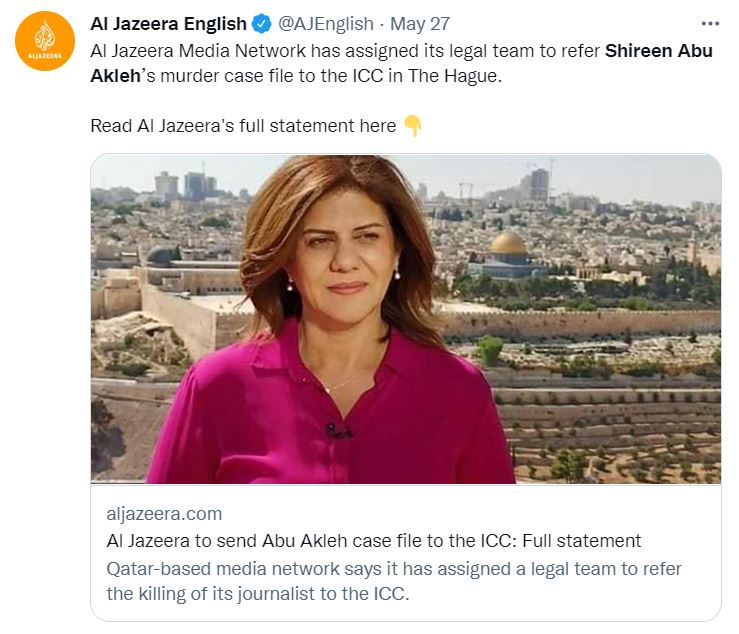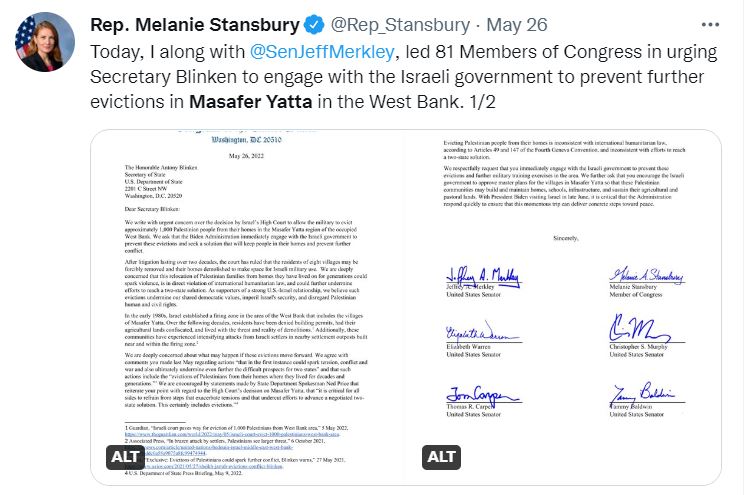Dear Friends,
This month included multiple reminders that the “status quo” continues to result in significant instability, violence, and on-the-ground changes over time. The controversial Jerusalem flag parade took place with increased levels of local confrontation. Public opinion shifts regarding Israeli access to Temple Mount/Haram Al-Sharif were reflected in record numbers of Israeli Jews visiting the site. The killing of journalist Shireen Abu Akleh sparked a strong show of Palestinian national unity and drew international attention. And the Israeli Ministry of Defense submitted an official position on the evacuation of the Homesh settlement outpost. Alongside these developments, plans for President Biden’s visit to Israel next month raises issues and opportunities worth following closely. These developments decreased the index by 2.0% in May (down 0.11 points from 5.63 to 5.52).
|
|
|
|
To learn about the Geneva Initiative's TSI, visit our website.
|
|
|
|
Nationalist Flag March Takes Place Through Jerusalem’s Damascus Gate
The annual Jerusalem Day flag parade reached an unprecedented level of participation this year, with some estimates as high as 70,000 Israeli marchers. The route of the march took place as planned through the Muslim Quarter of Jerusalem’s Old City, resulting in numerous clashes between Israeli participants, Palestinians, and the police. In the hours before the march, a record-breaking number of 2,600 Israeli Jews were permitted entry to the Temple Mount/Haram al-Sharif, including far-right MK Itamar Ben Gvir. Journalists reported higher levels of friction in comparison to previous years; video clips of marchers chanting racist incitement and violent clashes circulated widely on social media.
There were several marked differences from last year’s Jerusalem Day parade, which was rerouted away from the Damascus Gate and marked by a police ban on allowing entry of Jewish Israelis to the Temple Mount/Al Aqsa Compound, amidst a broader escalation between Israel and Hamas. Despite the size of the march, the controversial route, and explicit threats of renewed escalation from Hamas, outbreaks of violence this year were localized, with clashes taking place along the route of the march as well as on the Temple Mount/Al Aqsa and in the Sheikh Jarrah neighborhood.
|
|
|
|

Prior to the day, Palestinian militant factions in Gaza warned that the decision to allow the march to go through Damascus Gate and the Muslim Quarter was “a powder keg that will explode the whole area.” The contentious Jerusalem Day flag parade was the impetus for an 11-day war with Gaza last year, and with tensions soaring ahead of this year’s march, Hamas fired four rockets into the sea off Gaza in a warning to Israel. Despite its rhetoric, Hamas has signaled in recent months that it is uninterested in a new round of fighting with Israel as the Palestinian enclave continues to recover from last year’s devastating war and benefit from recently announced confidence-building steps, including an unprecedented number of work permits for Gazan laborers.
The reversed-scale “Settler Violence” parameter moved from 8 to 7 this month due to the negative affect of the Jerusalem Day parade violence on preparing the ground for peace. The “Holy Sites” parameter decreased from 6 to 5 due to the highlighted trend of increasing Jewish visits to the Temple Mount/Al Aqsa compound and the threat this poses to the status quo.
|
|
|
|
Killing of Al Jazeera Journalist in West Bank Unifies Palestinian Society in Shock and Outrage
|
|
|
|

A conclusive determination as to who bears responsibility for Abu Akleh’s death is unlikely due to a deep lack of trust between the sides. The PA holds the IDF responsible for deliberately targeting Abu Akleh, while Israel maintains that without access to the bullet, it cannot determine whether Abu Akleh was killed by Israeli or Palestinian gunfire. Neither the Israeli government nor the PA are likely to accept the findings of the other.Meanwhile, footage of Israeli soldiers tearing down Palestinian flags from Abu Akleh’s coffin during her funeral procession was widely viewed as an Israeli attempt to delegitimize the Palestinian national flag. “The killing of Al Jazeera correspondent Shireen Abu Akleh came as a wakeup call to Palestinians, who put aside their endless differences and united behind one flag, the Palestinian national flag. The Israeli police’s relentless and violent attack on Palestinian flag holders at Abu Akleh’s funeral opened a new arena in the Palestinian-Israeli conflict: the flag,” analyst Mohammed Daragmeh says. The killing of Abu Akleh, also an American citizen, and the violence that ensued at her funeral drew international attention back to the conflict. The European Union said it was “appalled” by images of Israeli police beating mourners at the start of Abu Akleh’s funeral, while US President Joe Biden said the incident “must be investigated.” US Secretary of State Antony Blinken spoke with Abu Akleh’s family, offering them the support of US diplomats in Jerusalem, earlier stating that he was “deeply troubled” by the conduct of Israeli police.
|
|
|
|
With Status Quo In Question, New Poll Finds Half of Israelis Support Jewish Prayer on Temple Mount:
A new poll by the Israel Democracy Institute (IDI) published this month finds that 50% of Jewish Israelis support allowing Jews to pray on the Temple Mount, with 38% supporting Jewish prayer as proof of Israel’s sovereignty over the site. Meanwhile, a decision by the Jerusalem Magistrate’s Court this month in favor of three Jewish teenagers who were temporarily barred from Temple Mount/Haram al-Sharif after they bowed down and recited the “Shema Yisrael” prayer further fueled accusations that Israel has challenged the fragile status quo at the Holy Site by turning a blind eye to quiet Jewish prayer at the site. In a rare move, Israel’s Prime Minister’s Office responded to the Magistrate Court’s ruling, clarifying that “there is no change, nor is any change planned, on the status quo of the Temple Mount,” and that the court’s ruling “does not constitute a broader determination regarding the freedom of worship on the Temple Mount.” The decision was ultimately overturned by the Jerusalem District Court in a ruling that determined Jewish freedom of worship “should be superseded by other interests, among them the safeguarding of public order.”
|
|
|
|
Another notable finding in the IDI poll is a slight increase in optimism among Israelis regarding the future of Israel’s security relative to last month’s numbers, although those who see it favorably remain a minority at 38%. Optimism regarding the future of democratic rule in Israel is comparable, at 40%. Both statistics are reflective of current Israeli perspectives on the conflict and its impact on Israeli society.
The “Israeli Public Opinion” parameter decreases from 7 to 6 in light of trends that threaten the status quo of the Temple Mount/Al Aqsa compound. The “Holy Sites” parameter similarly decreases from 6 to 5.
|
|
|
|
Developments in the Settlements: Planned Expansion and Evictions
Israel this month announced plans to advance 4,427 settlement homes, acquiescing to more right-wing elements of the crumbling Israeli coalition while testing US opposition. Included in the plans were 2,791 homes which received final approvals and 1,636 homes which were advanced through the first stages of planning. The plans include the retroactive approval of three illegal outposts (Mitzpeh Danny, Oz veGaon, Givat HaBooster) which were approved as new “neighborhoods” belonging to existing communities in order to avoid announcing the establishment of new settlements. Of the 4,427 units included in the plans, 2,523 are in settlements east of the proposed Geneva Initiative border, which are likely to be evacuated as part of a two-state agreement.
|
|
|
|
The settlement of Homesh has made media waves this month as well. In a position submitted to the Israeli High Court, the Defense Ministry stated that the outpost is illegal and should be evacuated, but refrained from setting a timeline. In a Blue and White party meeting, Defense Minister Benny Gantz reiterated that “Israeli law requires” the evacuation of Homesh. An Israeli civil society demonstration in the West Bank, organized by Peace Now and advocating for immediate evacuation, took place in late May.
|
|
|
|

In the US, 83 Democratic lawmakers from both houses of Congress penned a letter to US Secretary of State Antony Blinken urging him to intervene on Masafer Yatta. In a meeting with PA President Abbas this month, EU Parliament President Roberta Metsola said that “achieving peace in Middle East remains a key priority for EU and for the international community” and that “the European Parliament will keep doing all we can to reinvigorate the peace process,” reaffirming European support for a two-state solution. Mention of the peace process was notably absent from statements following Metsola’s reciprocal meeting with PM Bennett in Israel.The reverse-scale “Settlement Planning” parameter decreases from 5 to 4 this month due to the government announcement of thousands of settlement homes. The “International Public Opinion” parameter increases from 6 to 7 due to increased international attention and vocal opposition to specific detrimental policies, as well as reiterated general support for a two-state solution.
|
|
|
|
Preparing for President Biden’s Visit
US President Joe Biden is reportedly planning a visit to Israel at the end of June at the invitation of Israeli PM Naftali Bennett. While the trip itself and what it will include has not been officially announced, media reports indicate that Biden’s visit will also include a meeting with PA President Abbas in the West Bank and a visit to East Jerusalem without an Israeli escort. Both would widely be seen as a gesture of support for the Palestinians and an intention to strengthen diplomatic relations. Open issues worth following in the Biden visit:
- Developments in the structure of American-Palestinian diplomatic relations, particularly on issues relating to the consulate in Jerusalem, will be an important aspect of a Biden trip, particularly if it includes a visit to East Jerusalem. Palestinian frustration that the Biden administration has not reopened the consulate office could be addressed by the introduction of a new diplomatic framework that allows for a channel between the US and the PA independent of the American Embassy in Israel.
- The issue of PA payments to Palestinian prisoners is a sensitive question with political import for American congressional and financial support to the PA. The Biden administration and the PA have been discussing possible arrangements to ameliorate tensions over this policy; any developments on this will likely be influenced by the question of a closer mechanism for diplomatic relations mentioned above.
- An additional diplomatic front that could arise in connection to the visit are Israeli-Saudi relations. In the event that there is development towards normalization, the question will be whether and to what extent establishing diplomatic relations between Saudi Arabia and Israel will be connected to progress on the peace process and concessions on issues related to Palestinians.
|
|
|
|
The Two-State Index (TSI) is brought to you by the Geneva Initiative, a Palestinian-Israeli organization working to promote a negotiated peace agreement in the spirit of the two-state vision. The TSI is produced by an Israeli-Palestinian team, and reflects a unique bilateral perspective.
|
|
|
|
Think we missed something this month? Send us tips and comments here.
|
|
|
|
|
|
|